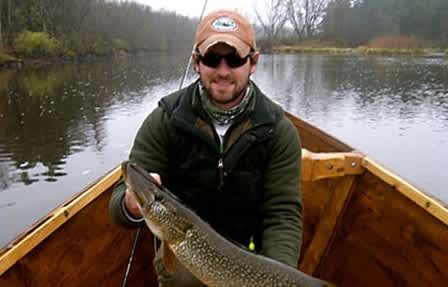West Meets Midwest: Exploring Wisconsin Fishing on a Drift Boat
Patrick Durkin 05.31.13


Dave Bakken pulled and pushed on his oars, quietly guiding his wooden boat down the Chippewa River and beneath its steep banks, foot bridges, and old brick-and-mortar buildings in downtown Eau Claire, Wisconsin.
The Chippewa was swollen with runoff from recent snowstorms and the usual spring variety, staining its waters and pushing us along faster than Bakken preferred. No matter how much he strained on the oars, we often rolled too quickly past eddies and quiet holes I was trying to work with various spoons and crankbaits.
As we passed beneath sidewalks and alongside walking trails on a pleasant Wisconsin weekend, people paused to watch and wave, and ask if the fish were biting. They weren’t, but Bakken, 25, kept churning with his oars as I kept shooting casts toward logs, submerged rocks, and undercut riverbanks.
We never felt discouraged. After all, we had the water to ourselves, thanks to the Elvegris, Bakken’s 16-foot drift-boat he built two years ago with his father, Ron.
The scene reminded me of Aldo Leopold describing how to “steal” a grouse hunt in his book, A Sand County Almanac. In the chapter titled “October: Smoky Gold,” Leopold wrote: “The sweetest hunts are stolen. To steal a hunt, either go far into the wilderness where no one has been, or find some undiscovered place under everybody’s nose.”
You can’t fish in more solitude while beneath so many noses as you’ll find on warm, quiet evenings in downtown Eau Claire. Yes, it would have been even more fun to catch a muskie, smallmouth bass, or northern pike, but there’s something satisfying about fishing while passersby stare enviously at your host’s handcrafted boat and mark its quiet progress downriver.
Dave and Ron Bakken of Eau Claire launched their idea of building a Western drift boat after Dave bought his father a guided fly fishing trip for muskies on a river near Hayward. They enjoyed the experience so much that they joked about trading their regular boat and outboard engine for the first double-ended drift boat they saw.
But because Western drift boats are about as rare in Wisconsin as bull moose and mountain lions, the Bakkens realized they’d have to wait awhile to see one worth buying. That prompted them to consider building one from plywood. After scouring the Internet and studying various models and designs, they downloaded the plans for a double-ender that fit their needs.

Their boat measures 16 feet, 6 inches bow to bow, and required six months of work to complete. Its upturned, double-bow construction allows it to turn quickly and remain stable while sliding through the narrow chutes and churning waters of river rapids.
And even while carrying three adults, the Elvegris can slip through eight-inch waters, putting it on par with canoes and kayaks for crossing difficult shallows.
Given the boat’s nimble moves and light touch on the water, why did the Bakkens name it “elvegris,” which means “river pig” in Norwegian? Because River Pig is the name of a favored craft beer at the Angry Minnow Brew Pub & Restaurant in Hayward.
“We have a Norwegian background, so we wanted to tie it into our boat somehow,” Dave said.
He also credits their Norwegian heritage for the perseverance to build the Elvegris. Although their boat plans produced a safe, handsome boat, the plans didn’t include step-by-step construction tips.
“We had to figure out a lot of things through trial and error, so it got frustrating at times,” Dave said. “We’d get three steps into something, realize we were going wrong, and have to start over.”
The Bakkens used half-inch thick construction plywood for the hull, and covered its exterior with epoxy and fiberglass, with extra layers on the bottom to protect the Elvegris from rocks. To save money and allow the wood to breathe, they use a mixture of linseed oil and pine tar on the interior instead of epoxy and fiberglass. The mix must be applied several times a year for upkeep.
As with all boat builders, the Bakkens started modifying the boat’s interior almost as soon as they completed its maiden voyage down the Eau Claire and Chippewa rivers in October 2011. “You can’t know a boat’s needs until you actually take it fishing on the river a few times,” Dave said.

For instance, to avoid tripping over the boat’s internal ribs, they installed a removable floor made from tongue-in-groove cedar. They also installed a knee brace up front so the designated fisherman can brace against something solid when the oarsman suddenly changes direction without warning.
The boat’s maneuverability and responsiveness isn’t restricted to the water, either. Although the task of reloading the Elvegris onto its trailer is best done at a launch, the Bakkens think nothing of unloading it 100 or more yards from a river and pushing it to the water.
Dave Bakken especially likes chasing muskies in fall with big flies, and smallmouths in midsummer with surface poppers. “You can catch muskies, smallies, and pike with the same type of lures and flies,” he said. “Sometimes you’ll catch all three on the same trip. It just depends on the day and what you want to do.”
Since building the boat with his dad, Dave Bakken accepted a job in Superior and lives in Duluth. That allows him to also fish and explore northwestern Wisconsin’s rivers with the Elvegris.
“Exploring a river is almost as much fun as the fishing itself,” Dave said. “It never gets dull, and you can never take rapids for granted. You see them on maps and ask people about them beforehand, but they’re always changing, depending on the water flow. You always wonder how big they’ll be each time you head downriver.”
So far, the Bakkens haven’t encountered anything the river pig can’t handle.

